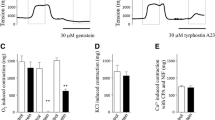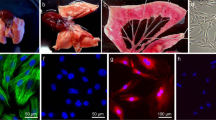Abstract
Closure of the ductus arteriosus (DA) after birth, essential for postnatal adaptation, is initiated by the transition from hypoxia to normoxia. The current study investigated how hypoxia affects the level of cytosolic calcium ([Ca2+]i) in fetal lamb DA smooth muscle cells (DASMCs) and the role of calcium pumps in this process. The [Ca2+]i variation in response to acute hypoxia was determined spectrofluorometrically with fura-3-AM in cultured fetal DASMCs. Interventions using chemicals or solutions including thapsigargin, vanadate, KB-R7943, alkaline PH9.0 solution, or Na+-free medium were administered when samples were exposed to acute hypoxia. The results show that [Ca2+]i decreased dramatically under acute hypoxia. This decrease was not attenuated completely by an inhibitor of sarcoplasmic/endoplasmic reticulum Ca2+ adenosine triphosphatase (ATPase) (SERCA), a blocker of plasma membrane Ca2+ ATPase (PMCA), or an inhibitor and activator of the reserve mode of the Na+/Ca2+ exchanger (NCX). In contrast, KT-R9743, an inhibitor of the forward mode of NCX at a high concentration (30 μm), greatly diminished the hypoxia-induced [Ca2+]i decrease in fetal DASMCs. These results suggest that a hypoxia-induced Ca2+ decrease in fetal DASMCs results from cytosolic Ca2+ efflux mediated primarily by the forward mode of NCX.






Similar content being viewed by others
References
Abman S, Kinsella J, Mercier J (1999) Nitric oxide and endothelin in the developing pulmonary circulation: physiologic and clinical implications. In: Gaultier CBJ, Post M (eds) Lung development 1999. Oxford University Press, New York, p 196
Annunziato L, Pignataro G, Di Renzo GF (2004) Pharmacology of brain Na+/Ca2+ exchanger: from molecular biology to therapeutic perspectives. Pharmacol Rev 56:633–654
Assali NS, Kirchbaum TH, Dilts PV (1968) Effects of hyperbaric oxygen on utero placental and fetal circulation. Circ Res 22:573–588
Bers DM, Despa S (2006) Cardiac myocytes Ca2+ and Na+ regulation in normal and failing hearts. J Pharmacol Sci 100:315–322
Cantley LC Jr, Josephson L, Warner R et al (1977) Vanadate is a potent (Na, K)-ATPase inhibitor found in ATP derived from muscle. J Biol Chem 252:7421–7423
Carafoli E (1992) The Ca2+ pump of the plasma membrane. J Biol Chem 267:2115–2118
Clyman RI (2000) Ibuprofen and patent ductus arteriosus. N Engl J Med 343:728–730
Cornfield DN, Stevens T, McMurtry IF et al (1994) Acute hypoxia causes membrane depolarization and calcium influx in fetal pulmonary artery smooth muscle cells. Am J Physiol 266:L469–L475
Fay FS (1971) Guinea pig ductus arteriosus: I. Cellular and metabolic basis for oxygen sensitivity. Am J Physiol 221:470–479
Gros R, Afroze T, You XM et al (2003) Plasma membrane calcium ATPase overexpression in arterial smooth muscle increases vasomotor responsiveness and blood pressure. Circ Res 93:614–621
Guibert C, Flemming R, Beech DJ (2002) Prevention of a hypoxic Ca(2+)(i) response by SERCA inhibitors in cerebral arterioles. Br J Pharmacol 135:927–934
Heyman MA, Rudolph AM (1975) Control of the ductus arteriosus. Physiol Rev 55:62–78
Host A, Halken S, Kamper J et al (1988) Prostaglandin E1 treatment in ductus dependent congenital cardiac malformation: a review of the treatment of 34 neonates. Dan Med Bull 35:81–84
Imamura S, Nishikawa T, Hiratsuka E et al (2000) Behavior of smooth muscle cells during arterial ductal closure at birth. J Histochem Cytochem 48:35–44
Inesi G, Hua S, Xu C et al (2005) Studies of Ca2+ ATPase (SERCA) inhibition. J Bioenerg Biomembr 37:365–368
Ishida Y, Paul RJ (2005) Ca2+ clearance in smooth muscle: lessons from gene altered mice. J Smooth Muscle Res 41:235–245
Iwamoto T, Watano T, Shigekawa M (1996) A novel isothiourea derivative selectively inhibits the reverse mode of Na+/Ca2+ exchange in cells expressing NCX1. J Biol Chem 271:22391–22397
Karaki H, Ozaki H, Hori M (1997) Calcium movements, distribution, and functions in smooth muscle. Pharmacol Rev 49:157–230
Keck M, Resnik E, Linden B et al (2005) Oxygen increases ductus arteriosus smooth muscle cytosolic calcium via release of calcium from inositol triphosphate-sensitive stores. Am J Physiol Lung Cell Mol Physiol 288:L917–L923
Kim MY, Seol GH, Liang GH et al (2005) Na+-K+ pump activation inhibits endothelium-dependent relaxation by activating the forward mode of Na+/Ca2+ exchanger in mouse aorta. Am J Physiol Heart Circ Physiol 289:H2020–H2029
Li SZ, Wu F, Wang B, Wei GZ et al (2007) Role of reverse mode Na+/Ca2+ exchanger in the cardioprotection of metabolic inhibition preconditioning in rat ventricular myocytes. Eur J Pharmacol 561:14–22
Penniston JT, Enyedi A (1998) Modulation of the plasma membrane Ca2+ pump. J Membr Biol 165:101–109
Pignataro G, Tortiglione A, Scorziello A et al (2004) Evidence for a protective role played by the Na+/Ca2+ exchanger in cerebral ischemia induced by middle cerebral artery occlusion in male rats. Neuropharmacology 46:439–448
Sanders KM (2001) Invited review: mechanisms of calcium handling in smooth muscles. J Appl Physiol 91:1438–1449
Singh GK, Fong LV, Salmon AP et al (1994) Study of low-dosage prostaglandin usages and complications. Eur Heart J 15:377–381
Szentesi P, Pignier C, Egger M et al (2004) Sarcoplasmic reticulum Ca2+ refilling controls recovery from Ca2+-induced Ca2+ release refractoriness in heart muscle. Circ Res 95:807–813
Thebaud B, Michelakis ED, Wu XC et al (2004) Oxygen-sensitive Kv channel gene transfer confers oxygen responsiveness to preterm rabbit and remodeled human ductus arteriosus: implications for infants with patent ductus arteriosus. Circulation 110:1372–1379
Tiffert T, Lew VL (2001) Kinetics of inhibition of the plasma membrane calcium pump by vanadate in intact human red cells. Cell Calcium 30:337–342
Acknowledgments
This work was supported by a grant from the National Natural Science Foundation of China (no. 30471712) and Science Foundation for The Excellent Youth Scholars of Ministry of Health of Shanghai (no. 2008Y065).
Author information
Authors and Affiliations
Corresponding author
Rights and permissions
About this article
Cite this article
Hong, H., Chen, H., Gao, W. et al. Hypoxia-Induced Cytosolic Calcium Decrease Is Mediated Primarily by the Forward Mode of Na+/Ca2+ Exchanger in Smooth Muscle Cells of Fetal Ductus Arteriosus. Pediatr Cardiol 30, 958–964 (2009). https://doi.org/10.1007/s00246-009-9478-2
Received:
Revised:
Accepted:
Published:
Issue Date:
DOI: https://doi.org/10.1007/s00246-009-9478-2




